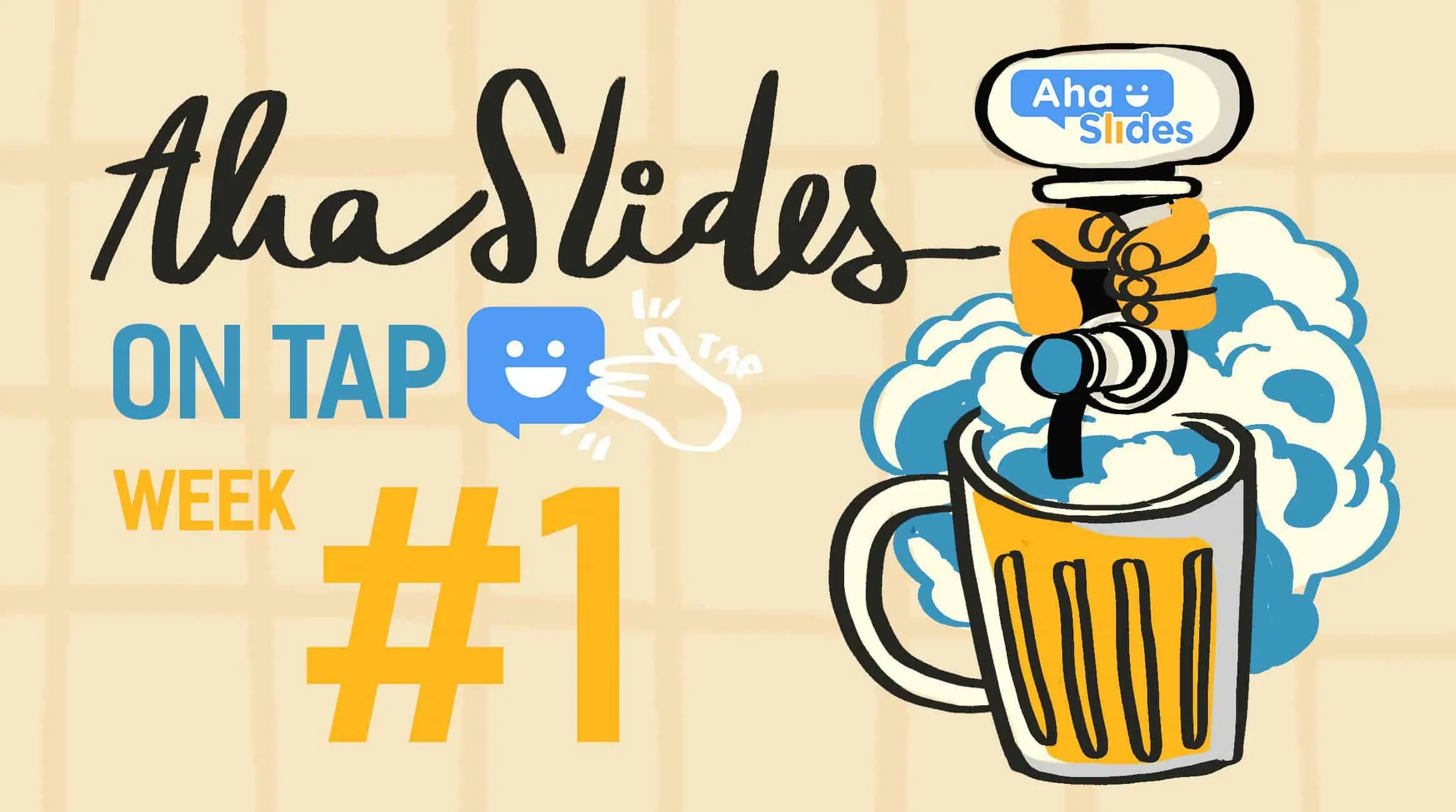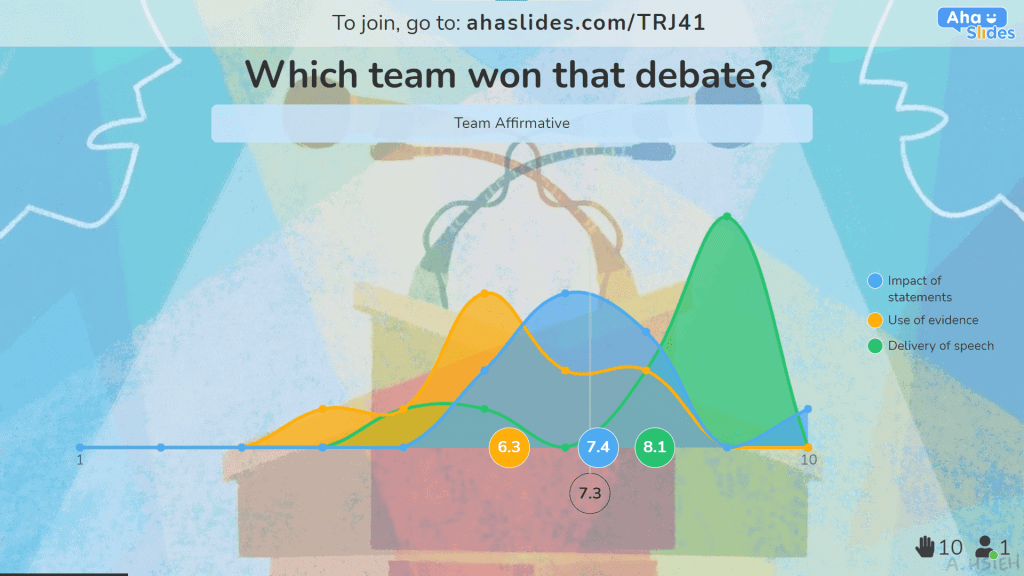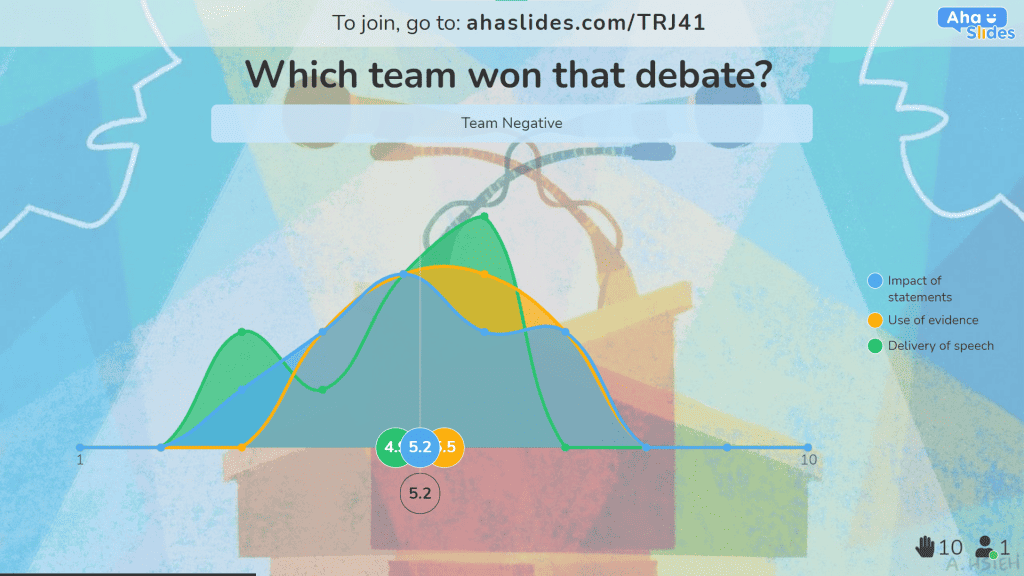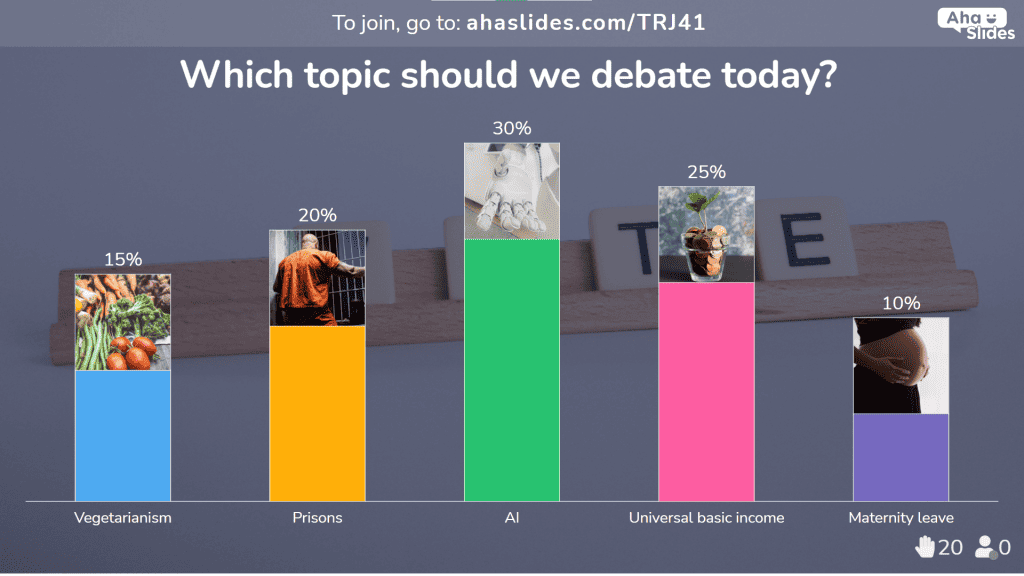Nie ma tu żadnej dyskusji; debaty studenckie to jeden z najlepszych sposobów zachęcania do krytycznego myślenia, angażować uczniów i oddaj naukę w ręce uczniów.
Jak więc przeprowadzić debatę studencką? Nie są one przeznaczone wyłącznie dla klas argumentacyjnych lub początkujących polityków, ani nie są przeznaczone wyłącznie dla mniejszych lub bardziej dojrzałych kursów. Debaty studenckie są dla każdego i słusznie stają się podstawą szkolnych programów nauczania.
Tutaj zanurzamy się w świat debat w klasie. Przyglądamy się korzyściom i różnym typom debat studenckich, a także tematom, świetnemu przykładowi i, co najważniejsze, sposobowi zorganizowania własnej owocnej, znaczącej debaty klasowej w 6 prostych krokach.
Dowiedz się więcej o naszej firmie interaktywne zajęcia w klasie!
Omówienie
| Ile minut powinna trwać debata? | 5 minut/sesję |
| Kto jest ojcem debaty? | Protagoras z Abdery |
| Kiedy odbyła się pierwsza debata? | 485-415 p.n.e. |
Więcej wskazówek dotyczących AhaSlides

Zacznij w kilka sekund.
Pobierz bezpłatne szablony debat studenckich. Zarejestruj się za darmo i weź to, co chcesz z biblioteki szablonów!
🚀 Uzyskaj bezpłatne szablony ☁️
Jak przeprowadzić debatę studencką? Spis treści
- Omówienie
- Więcej wskazówek dotyczących AhaSlides
- Dlaczego debaty studenckie potrzebują więcej miłości
- 6 kroków do przeprowadzenia debaty studenckiej
- 3 różne rodzaje debat studenckich do wypróbowania
- 40 tematów debat studenckich
- Idealny przykład debaty studenckiej
- Najczęściej zadawane pytania
Dlaczego debaty studenckie potrzebują więcej miłości

Regularne debaty w klasie mogą głęboko kształtować zarówno osobiste, jak i zawodowe aspekty życia ucznia. Oto kilka sposobów, w jakie prowadzenie znaczących dyskusji w klasie może być poważną, wartościową inwestycją w teraźniejszość i przyszłość uczniów:
- Moc perswazji – Debaty studenckie uczą uczniów, że zawsze istnieje kontemplacyjne, oparte na danych podejście do każdego impasu. Uczniowie uczą się, jak formułować przekonujący, wyważony argument, który dla niektórych może być pomocny w codziennym życiu w przyszłości.
- Cnota tolerancji – Z drugiej strony, prowadzenie debaty studenckiej w klasie również rozwija umiejętności słuchania. Uczy uczniów, aby naprawdę słuchali opinii, które różnią się od ich własnych i rozumieli źródła tych różnic. Nawet przegrana w debacie pozwala uczniom zrozumieć, że zmiana zdania w danej sprawie jest w porządku.
- 100% możliwe online – W czasach, gdy nauczyciele wciąż zmagają się z migracją doświadczeń w klasie do Internetu, debaty studenckie oferują bezproblemową aktywność, która nie wymaga fizycznej przestrzeni. Oczywiście, trzeba wprowadzić pewne zmiany, ale nie ma powodu, dla którego debaty studenckie nie powinny być częścią Twojego podejścia do nauczania online.
- Zorientowany na ucznia – Korzyści z stawiania uczniów, a nie przedmiotów, w centrum nauczania jest już dobrze zbadane. Debata studencka daje uczniom mniej lub bardziej swobodne panowanie nad tym, co mówią, co robią i jak reagują.
6 kroków do przeprowadzenia debaty studenckiej
Krok 1 – Przedstaw temat
Jeśli chodzi o strukturę debaty, pierwszym krokiem do zorganizowania debaty szkolnej jest oczywiście zapewnienie im tematu do rozmowy. Zakres tematów debaty klasowej jest praktycznie nieograniczony, nawet improwizowane tematy debaty. Możesz złożyć dowolne oświadczenie lub zadać dowolne pytanie typu „tak/nie” i pozwolić obu stronom na to, pod warunkiem, że zapewnisz zasady debaty.
Mimo wszystko, najlepszym tematem jest ten, który dzieli twoją klasę tak blisko środka, jak to możliwe. Jeśli potrzebujesz inspiracji, mamy 40 tematów debat studenckich Tu na dole.
Świetnym sposobem na wybranie idealnego tematu jest zbieranie wstępnych opinii na ten temat w Twojej klasiei zobaczyć, który z nich ma mniej więcej parzystą liczbę uczniów po każdej stronie:

Chociaż prosta ankieta tak / nie, jak ta powyżej, może zrobić, istnieje wiele innych kreatywnych sposobów określenia i skonfigurowania tematu do omówienia przez uczniów:
- Ankieta dotycząca obrazu – Zaprezentuj kilka obrazków i sprawdź, z którym z nich każdy uczeń najbardziej się utożsamia.
- Chmura słów – Zobacz, jak często klasa używa tego samego słowa, wyrażając swoje opinie.
- Skala ocen – Przedstaw stwierdzenia na skali ruchomej i poproś uczniów o ocenę zgodności w skali od 1 do 5.
- Pytania otwarte – Daj uczniom swobodę wyrażania swoich opinii na dany temat.
Bezpłatne pobieranie! ⭐ Wszystkie te pytania znajdziesz w bezpłatnym szablonie AhaSlides poniżej. Twoi uczniowie mogą odpowiedzieć na te pytania na żywo za pośrednictwem swoich telefonów, a następnie zobaczyć wizualizowane dane dotyczące opinii całej klasy.
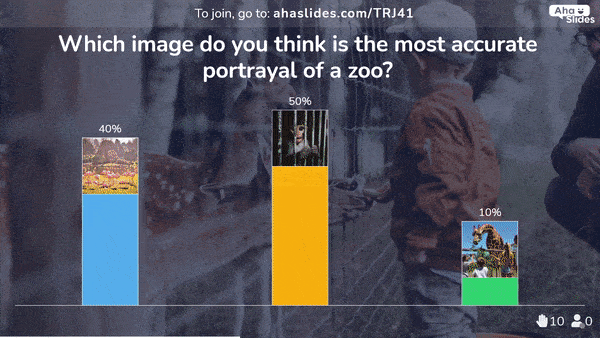
AhaSlides otwiera dyskusję.
Użyj tego bezpłatnego, interaktywnego szablonu, aby zebrać opinie uczniów na żywo w klasie. Rozpocznij konstruktywne dyskusje. Nie trzeba się rejestrować!
Pobierz darmowy szablon!
Krok 2 – Utwórz zespoły i określ role
Mając temat w torbie, następnym krokiem jest utworzenie 2 stron, które go omawiają. W debacie strony te są znane jako twierdzący i negatywny.
- Zespół potwierdzający – Strona zgadzająca się z proponowanym oświadczeniem (lub głosująca „tak” na proponowane pytanie), co zazwyczaj oznacza zmianę status quo.
- Zespół negatywny – Strona nie zgadza się z proponowanym oświadczeniem (lub głosuje „nie” na proponowane pytanie) i chce, aby wszystko pozostało bez zmian.
Tak naprawdę, 2 strony to absolutne minimum, którego potrzebujesz. Jeśli masz dużą klasę lub znaczną liczbę uczniów, którzy nie są całkowicie za twierdzącą lub negatywną, możesz zwiększyć potencjał uczenia się, zwiększając liczbę zespołów.
- Drużyna Middle Ground – Strona chce zmienić status quo, ale nadal zachowuje pewne rzeczy takie same. Mogą obalać argumenty obu stron i próbować znaleźć kompromis między nimi.
Wskazówka #1 💡 Nie karz niezdecydowanych. Chociaż jednym z powodów, dla których organizuje się debaty studenckie, jest sprawienie, by uczniowie nabrali pewności siebie w wyrażaniu swoich opinii, zdarzają się chwile, gdy naprawdę w środkuPozwólmy im zająć to stanowisko, ale powinni wiedzieć, że nie jest to biletem powrotnym z debaty.
Reszta twojej klasy będzie się składać sędziowie. Wysłuchają każdego punktu debaty i ocenią ogólną wydajność każdej drużyny w zależności od system oceniania wyruszyłeś później.
Jeśli chodzi o role każdego mówcy w zespole, możesz je ustawić tak, jak chcesz. Jednym z popularnych formatów debat studenckich w klasie jest ten używany w brytyjskim parlamencie:
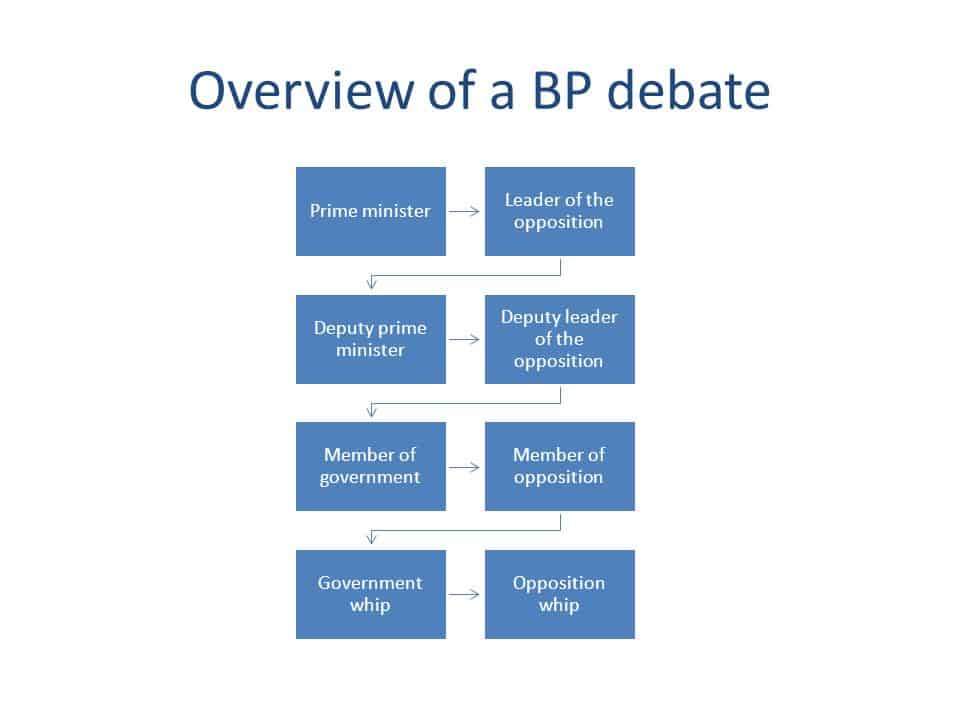
Obejmuje to 4 mówców w każdym zespole, ale możesz rozszerzyć to na większe klasy, przypisując po dwóch uczniów do każdej roli i przyznając im po jednym punkcie w wyznaczonym czasie.
Krok 3 – Wyjaśnij, jak to działa
Istnieją 3 kluczowe części debaty studenckiej, które musisz wyjaśnić przed rozpoczęciem. To są twoje barykady przeciwko rodzajowi anarchicznej debaty, której możesz doświadczyć w rzeczywisty brytyjski parlament. Istotnymi częściami debaty są The reguły i system oceniania.
— Struktura —
Debata studencka musi przede wszystkim mieć solidną strukturę i być zgodna z wytycznymi dotyczącymi debaty. Tak musi być boczny tak, aby nikt nie mógł przegadać siebie nawzajem, a musi to umożliwiać odpowiednie czas aby uczniowie mogli przedstawić swoje uwagi.
Zapoznaj się ze strukturą tej przykładowej debaty studenckiej. Debata zawsze zaczyna się od „Team Affirmative”, a po niej następuje „Team Negative”
| Zespół potwierdzający | Zespół negatywny | Dodatek czasowy dla każdej drużyny |
| Oświadczenie otwierające przez pierwszego głośnika. Przedstawią główne punkty poparcia dla proponowanej zmiany | Oświadczenie otwierające przez pierwszego głośnika. Przedstawią główne punkty poparcia dla proponowanej zmiany | 5 minut |
| Przygotuj odparcia. | Przygotuj odparcia. | 3 minut |
| Obalenie przez 2. mówcę. Będą oni polemizować z punktami przedstawionymi w oświadczeniu otwierającym Team Negative. | Obalenie przez 2. mówcę. Będą oni polemizować z punktami przedstawionymi w oświadczeniu otwierającym Team Affirmative. | 3 minut |
| Drugie obalenie przez 3. mówcę. Odrzucą replikę Team Negative. | Drugie obalenie przez 3. mówcę. Odrzucą replikę Team Affirmative. | 3 minut |
| Przygotuj oświadczenie obalające i końcowe. | Przygotuj oświadczenie obalające i końcowe. | 5 minut |
| Ostateczne oświadczenie obalające i końcowe przez czwartego mówcę. | Ostateczne oświadczenie obalające i końcowe przez czwartego mówcę. | 5 minut |
Tip #2 💡 Struktury debaty studenckiej mogą być elastyczne podczas eksperymentowania z tym, co działa, ale powinien być osadzony w kamieniu gdy ostateczna struktura zostanie ustalona. Uważaj na zegar i nie pozwól mówcom przekroczyć swojego przedziału czasowego.
— Zasady —
Surowość Twoich zasad zależy od prawdopodobieństwa, że Twoja klasa rozpadnie się na polityków po wysłuchaniu oświadczeń otwierających. Jednak bez względu na to, kogo uczysz, zawsze będą uczniowie zbyt głośni i tacy, którzy nie chcą zabierać głosu. Jasne zasady pomagają Ci wyrównać szanse i zachęcić wszystkich do udziału.
Oto kilka z nich, które prawdopodobnie zechcesz wykorzystać podczas dyskusji w klasie:
- Trzymaj się struktury! Nie mów, gdy nie jest twoja kolej.
- Pozostań na temat.
- Bez przekleństw.
- Bez uciekania się do ataków osobistych.
— System punktacji —
Chociaż celem klasowej debaty nie jest tak naprawdę „wygrana”, prawdopodobnie odkryjesz, że naturalna chęć rywalizacji wśród uczniów wymaga uspokojenia ich punktami.
Możesz przyznawać punkty za…
- Wpływowe oświadczenia
- Dowody poparte danymi
- Elokwentna dostawa
- Silna mowa ciała
- Korzystanie z odpowiednich wizualizacji
- Prawdziwe zrozumienie tematu
Oczywiście ocenianie debaty nigdy nie jest grą czystych liczb. Ty lub Twój zespół sędziów musicie wykazać się najlepszymi umiejętnościami analitycznymi, aby zdobyć punkty dla każdej ze stron debaty.
Tip #3 💡 Do debaty w Klasa ESL, gdzie używany język jest znacznie ważniejszy niż zdobyte punkty, należy nagradzać takie kryteria, jak różne struktury gramatyczne i zaawansowane słownictwo. Jednocześnie możesz odjąć punkty za używanie języka ojczystego.
Krok 4 – Czas na badania i pisanie

Czy wszyscy wiedzą już o temacie i zasadach dyskusji w klasie? Świetnie! Czas przygotować argumenty.
Z twojej strony musisz tutaj zrobić ustawić limit czasu do badań, rozłóż kilka z góry określone źródła informacjii monitoruj swoich uczniów, aby mieć pewność, że pozostanie na temacie.
Powinni zbadać swoje punkty i burza mózgów możliwe riposty od drugiej drużyny i zdecydować, co powiedzą w odpowiedzi. Podobnie powinni przewidzieć punkty swoich przeciwników i rozważyć riposty.
Krok 5 – Przygotuj salę (lub Zoom)
Podczas gdy Twoje drużyny kończą punktację, czas przygotować się do występu.
Zrób wszystko, co w Twojej mocy, aby odtworzyć atmosferę profesjonalnej debaty, ustawiając stoły i krzesła naprzeciwko siebie w poprzek pomieszczenia. Zazwyczaj mówca stanie na podium przed swoim stołem i wróci do swojego stołu po zakończeniu mówienia.
Oczywiście, sprawy są nieco trudniejsze, jeśli organizujesz debatę studencką online. Mimo to, jest kilka zabawnych sposobów, aby zróżnicować zespoły w Zoom:
- Niech każdy zespół wymyśli kolory drużyny i ozdabiać nimi tła na Zoomie lub nosić je jako mundurek.
- Zachęć każdy zespół do wynalezienia maskotka drużyny i aby każdy członek pokazywał to na ekranie podczas debaty.
Krok 6 – Debata!
Niech rozpocznie się bitwa!
Pamiętaj, że to czas, kiedy twój uczeń musi zabłysnąć; staraj się wtrącać jak najmniej. Jeśli musisz mówić, upewnij się, że robisz to tylko po to, aby utrzymać porządek w klasie lub przekazać strukturę lub system punktacji. Ponadto, oto kilka przykłady wprowadzenia abyś podkręcił twoją debatę!
Zakończ debatę, oceniając każdą drużynę według kryteriów, które określiłeś w systemie punktacji. Twoi sędziowie mogą wypełniać punkty każdego kryterium w trakcie debaty, po czym punkty mogą zostać zliczone, a średnia liczba na każdym pasku będzie ostatecznym wynikiem drużyny.
Tip #4 💡 Kuszące może być przejście od razu do głębokiej analizy debaty, ale tak właśnie jest najlepiej zachować do następnej lekcji. Pozwól uczniom się zrelaksować, przemyśl punkty i wróć następnym razem, aby je przeanalizować.
Różne rodzaje debat studenckich do wypróbowania
Powyższa struktura jest czasami określana jako Format Lincolna-Douglasa, rozsławione przez serię ognistych debat między Abrahamem Lincolnem i Stephenem Douglasem. Jednak jest więcej niż jeden sposób na tango, jeśli chodzi o debatowanie w klasie:
- Debata na temat odgrywania ról – Uczniowie odgrywają debatę opartą na opiniach postaci fikcyjnej lub niefikcyjnej. To świetny sposób, aby zachęcić ich do otwarcia umysłów i próby przedstawienia przekonującego argumentu z poglądami odmiennymi od ich własnych.
- Zaimprowizowana debata – Pomyśl o szybkim quizie, ale do debaty! Improwizowane debaty studenckie nie dają mówcom czasu na przygotowanie, co jest dobrym ćwiczeniem umiejętności improwizacji i krytycznego myślenia.
- Debata w ratuszu – Dwóch lub więcej uczniów staje przed publicznością i odpowiada na pytania. Każda ze stron ma szansę odpowiedzieć na każde pytanie i może obalać się nawzajem, o ile pozostaje to mniej więcej cywilizowane!
Sprawdź 13 najlepszych niesamowitych Gry z debatą online dla uczniów w każdym wieku (+30 tematów)!
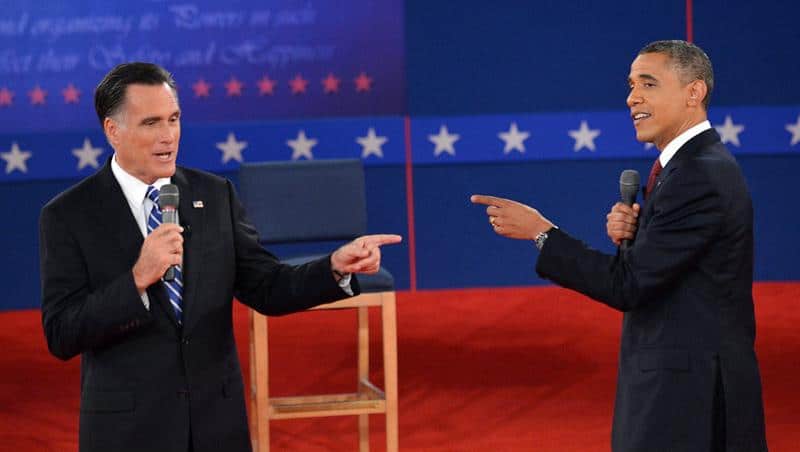
Potrzebujesz więcej sposobów na zaangażowanie uczniów? 💡 Sprawdź te 12 pomysłów na zaangażowanie uczniów albo przewrócona klasa technika do zajęć na żywo i online!
40 tematów debat studenckich
Szukasz inspiracji, aby przenieść debatę na salę lekcyjną? Zapoznaj się z poniższymi 40 tematami debat studenckich i zagłosuj ze swoimi uczniami, który wybrać.
Szkolne tematy do debaty studenckiej
- Czy powinniśmy stworzyć hybrydową klasę i mieć zarówno naukę zdalną, jak i w klasie?
- Czy powinniśmy zakazać noszenia mundurków w szkole?
- Czy powinniśmy zakazać pracy domowej?
- Czy powinniśmy wypróbować model uczenia się w odwróconej klasie?
- Czy powinniśmy więcej uczyć się poza domem?
- Czy powinniśmy znieść egzaminy i opierać się na testach przeprowadzanych w toku zajęć?
- Czy każdy powinien iść na uniwersytet?
- Czy czesne powinno być niższe?
- Czy powinniśmy mieć zajęcia na temat inwestycji?
- Czy e-sport powinien być częścią zajęć na siłowni?
Tematy środowiskowe do debaty studenckiej
- Czy powinniśmy zakazać ogrodów zoologicznych?
- Czy wolno trzymać egzotyczne koty jako zwierzęta domowe?
- Czy powinniśmy budować więcej elektrowni jądrowych?
- Czy powinniśmy spróbować spowolnić przyrost naturalny na całym świecie?
- Czy powinniśmy zakazać cała kolekcja plastik jednorazowego użytku?
- Czy powinniśmy zamienić prywatne trawniki w działki i siedliska dzikich zwierząt?
- Czy powinniśmy powołać „międzynarodowy rząd ds. środowiska”?
- Czy powinniśmy zmusić ludzi do zmiany sposobów walki ze zmianami klimatycznymi?
- Czy powinniśmy zniechęcać do „szybkiej mody”?
- Czy powinniśmy zakazać lotów krajowych w małych krajach z dobrymi systemami kolejowymi i autobusowymi?
Tematy społeczne do debaty studenckiej
- Powinniśmy cała kolekcja być wegetarianinem czy weganinem?
- Czy powinniśmy ograniczyć czas grania w gry wideo?
- Czy powinniśmy ograniczać czas spędzany w mediach społecznościowych?
- Czy wszystkie łazienki powinny być neutralne pod względem płci?
- Czy powinniśmy wydłużyć standardowy okres urlopu macierzyńskiego?
- Czy powinniśmy nadal wymyślać sztuczną inteligencję, która może to zrobić cała kolekcja Oferty pracy?
- Czy powinniśmy mieć powszechny dochód podstawowy?
- Czy więzienia powinny służyć karze czy resocjalizacji?
- Czy powinniśmy przyjąć system kredytu społecznego?
- Czy powinniśmy zakazać reklam wykorzystujących nasze dane?
Hipotetyczne tematy debaty studenckiej
- Gdyby nieśmiertelność była opcją, czy byś ją wybrał?
- Gdyby kradzież była legalna, czy zrobiłbyś to?
- Gdybyśmy mogli łatwo i tanio klonować zwierzęta, czy powinniśmy to zrobić?
- Gdyby jedna szczepionka mogła zapobiec cała kolekcja choroba rozprzestrzenialna, czy powinniśmy zmuszać ludzi do jej przyjmowania?
- Gdybyśmy mogli łatwo przenieść się na inną planetę, taką jak Ziemia, czy powinniśmy?
- If Nie zwierzęta były zagrożone wyginięciem, czy hodowla wszystkich zwierząt powinna być legalna?
- Gdybyś mógł nigdy nie pracować i nadal wygodnie żyć, czy zrobiłbyś to?
- Gdybyś mógł wybrać wygodne życie w dowolnym miejscu na świecie, czy przeprowadziłbyś się jutro?
- Gdybyś mógł kupić szczeniaka lub adoptować starszego psa, co byś wybrał?
- Gdyby jedzenie poza domem kosztowało tyle samo co gotowanie dla siebie, czy jadłbyś poza domem codziennie?
Możesz zechcieć dać swoim uczniom wybrane tematy debaty, którzy będą mieli ostatnie słowo, o którym zabiorą głos. Możesz użyć do tego prostej ankiety lub zadać bardziej szczegółowe pytania dotyczące cech każdego tematu, aby zobaczyć, który z nich najdogodniej omawiać.
Sonduj swoich uczniów za darmo! ⭐ AhaSlides pomaga umieścić uczniów w centrum klasy i dać im głos poprzez ankiety na żywo, quizy i wymianę pomysłów. Jeśli chodzi o zwiększanie zaangażowania uczniów, nie ma dyskusji.
Przykład idealnej debaty studenckiej
Zostawimy Was z jednym z absolutnie najlepszych przykładów debat studenckich z programu w koreańskiej sieci nadawczej Arirang. Program, Inteligencja – Debata w szkole średniej, ma prawie każdy aspekt pięknej debaty studenckiej, którą nauczyciele powinni dążyć do wniesienia do swoich klas.
Sprawdź to:
Tip #5 💡 Zarządzaj swoimi oczekiwaniami. Dzieci w tym programie są absolutnymi profesjonalistami, a wiele z nich prowadzi elokwentne debaty, mając angielski jako drugi język. Nie oczekuj, że Twoi uczniowie będą na tym samym poziomie – niezbędny udział to dobry początek!

Daj uczniom możliwość wypowiedzenia się.
Ankiety, quizy i rozwijaj swoją klasę, tworząc dialog. AhaSlides sprawia, że klasy są interaktywne i daje władzę uczniom.
Wypróbuj za darmo ☁️
Najczęściej zadawane pytania
Masz pytanie? Mamy odpowiedzi.
